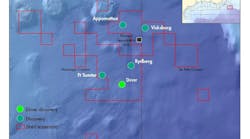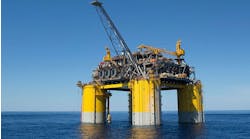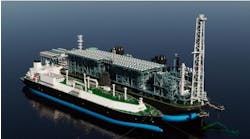David Shields
Special Correspondent
For the first time, Petróleos Mexicanos (Pemex) has budget available to spend on deepwater drilling and is getting ready to contract services for its first well, which is likely to be drilled in the Perdido fold belt on the Mexican side of the Gulf of Mexico maritime boundary. Pemex has put together a team of specialists to tackle deepwater issues.
Adan E. Oviedo, head of exploration efforts at Pemex's Exploration and Production division (PEP), says this will be a "gigantic challenge" for Pemex, which will take the company into unmapped territory. For decades, Pemex has exploited the rich fields in the shallow waters of Campeche Bay and has seen no need to venture into deepwater. At the same time, the state-run company was also subject to severe budgetary restrictions for exploration. However, the giant Cantarell field is expected to decline soon, emphasizing the need to open up new horizons.
"Pemex will be drilling its first deepwater well this year," Raul Muñoz, company CEO, said, without giving any details of what or where. Oviedo explains that PEP is hoping to drill a first exploratory well at 2,600 to 2,700 m (8,500 to 8,800 ft) in Perdido and that it could be the first of 10 to 12 wells in deepwater and ultra-deepwater areas that the company hopes to drill during the Fox government term, which ends in December 2006.
International support
Oviedo has confirmed that PEP has been talking to international oil companies about getting their support for these projects. This effort is like taking a leap into the dark for the company, as it has rarely gone beyond 200 m (650 ft) of water depth. PEP specialists have attended seminars organized by several international majors, and the company has technical agreements with some of them. These agreements are likely to be the basis for cooperation on PEP's first deepwater wells, as the country's constitution says that only Pemex can exploit hydrocarbons in Mexican territory and rules out any kind of production-sharing, profit-sharing, or joint ventures.
Muñoz recently spoke in public about Pemex's discussions on deepwater issues with about 10 international majors. Oviedo says that the companies Pemex has been talking to include Unocal, BPAmoco, Petrobras, Statoil, ExxonMobil, Shell, ChevronTexaco, and Total SA.
"We will need a lot of technology, a lot of capital and impeccable operating efficiencies," said Oviedo, who acknowledges that Pemex's future will be linked to deepwater. He adds that the company is very aware of the need to approach major operators, rather than traditional service companies, to get the expertise, but that sharing profits or production is not being considered. Instead, Pemex will look for help through technical assistance.
"We know that projects of this scope typically require sharing risk and forming alliances. The law does not allow for this at this point, so we will be lobbying for legal changes in order to enter into business arrangements and alliances that are different from the limited options in cooperation currently permitted by law," Oviedo said. For now, PEP specialists have been seeking residence and attending technical seminars with a view to reducing the gap in knowledge and ability between PEP and major deepwater operators. They are also trying to evaluate the business culture and the strengths that each company could bring to Mexican deepwater work.
Exploration
Based on PEP's definition of deepwater as 500 m (1,640 ft) water depth and above, and of ultra-deepwater as 1,500 m (4,900 ft) and above, PEP will be looking to drill eight to nine exploratory wells in deepwater, plus two to three in ultra-deepwater, including one or two in the Perdido fold belt, by year-end 2006. PEP has identified four areas in the Mexican Gulf with major potential, including the Perdido fold belt, the Mexican ridges, Coatzacoalcos deepwater, and the Campeche deepwater fold belt. Of the 10 to 12 wells PEP has slated to drill, plans are for at least one well to be in each of these regions.
PEP will be testing different oil-bearing geological systems in each region. In the Campeche deepwater area, it will be prospecting heavy oil. In Coatzacoalcos and in the Mexican ridges, the company is likely to find light oil with a high gas-to-oil ratio. Perdido is an attractive prospect, as there is a likelihood of finding 48° API oil, with the option of using existing infrastructure on the US side of the maritime boundary.
These wells are aimed at increasing PEP's information on these regions beyond what it has already gleaned from 2D and 3D seismic, Oviedo said. PEP will select the best sites from its limited knowledge. It will probably carry out bidding processes with a view to contracting semisubmersible rigs for much of the work, and it will need a vessel for the work in Perdido.
Oviedo acknowledges that there are no drillships available for such work at this point, so PEP might have some difficulty in finding an option for getting that first well drilled in Perdido. Certainly, time and circumstances are not on the company's side, if it is to reach its goal of starting drilling on the well in the remainder of this year, as promised by CEO Muñoz.
There are, however, several hundred millions of dollars of federal budget money available for deepwater, and PEP expects to start on tendering the work in the second half of this year. PEP now has a specific deepwater working group of seven permanent members, who can easily be complemented by other specialists on its E&P staff. This group is already looking at the complete cycle of deepwater work and will lead future projects, both in drilling key wells and understanding the geological models in the Mexican deepwater arena.
PEP may get as far as testing reserves, but is not expecting any production by yearend-2006 out of its first 10 deepwater wells. Rather, it hopes to evaluate the potential of prospective resources. Oviedo believes PEP will have to buy or rent technology on a massive, yet very selective, basis to get the work done.
Crossing over
In the case of Perdido, PEP is extrapolating available public information on successful projects on the US side, such as BAHA, Trident, and Great White, onto the Mexican side. Oviedo notes that 11 wells have been successfully drilled in Perdido on the US side of the maritime boundary, which together account for 1.1 Bbbl of proven and probable reserves. This raises considerable hope that major reserves might be found on the Mexican side, too. PEP is likely to use existing infrastructure on the US side, such as ExxonMobil's Diana Hoover module, to move future deepwater production from Perdido to markets.
PEP had already been moving its sights from shallow into deepwater in recent years. It has acquired 25,000 sq km of seismic in deepwater areas. Its current 2002-2006 plans include $700 million for seismic work. Drilling work by Diamond Offshore's Ocean Worker vessel on a 512 m (1,670 ft) well – the deepest water so far in Mexico – is currently being concluded and evaluation work on the well is beginning. Ocean Worker has been hired by PEP until 2007 and plans to drill five or six wells by then. This year it is to drill a well at 700 m (2,290 ft), Oviedo said. Diamond Offshore reported in June 2003 it had received drilling contracts from Pemex for three of its semisubmersibles. Oviedo foresees Pemex will be seeking more such rigs through bidding processes in the near future.
A good start
Most of PEP's offshore efforts continue to centered on Campeche Bay shallow-water plays, although it has recently made some minor discoveries in shallow waters near the city of Coatzacoalcos, as well as much farther north in the Lobina-1 well, which is just off the coast near Tampico. Offshore output from Campeche Bay reached a record 2.8 MMb/d last year, accounting for 83.5% of Mexico's total production of 3.4 MMb/d.
Supergiant Cantarell continues to be the mainstay of Mexican oil production, with 2.1 MMb/d of output in 2003, up from 1.9 MMb/d in 2002. However, Cantarell is expected to decline rapidly over the next few years, falling as far as 1 MMb/d by 2008. This has given particular urgency to Pemex's efforts to develop other fields and move into deepwater. For now, Pemex's best alternative project is the heavy-oil complex known as Ku-Maloob-Zaap, in Campeche Bay close to Cantarell. Output from this complex was 288,000 b/d in 2003 and is expected to rise to about 800,000 b/d by the end of the decade.




